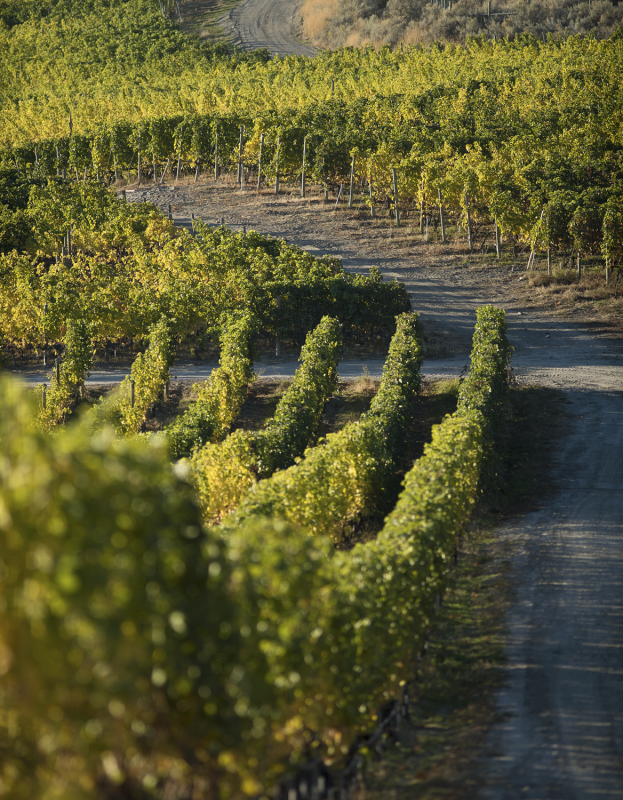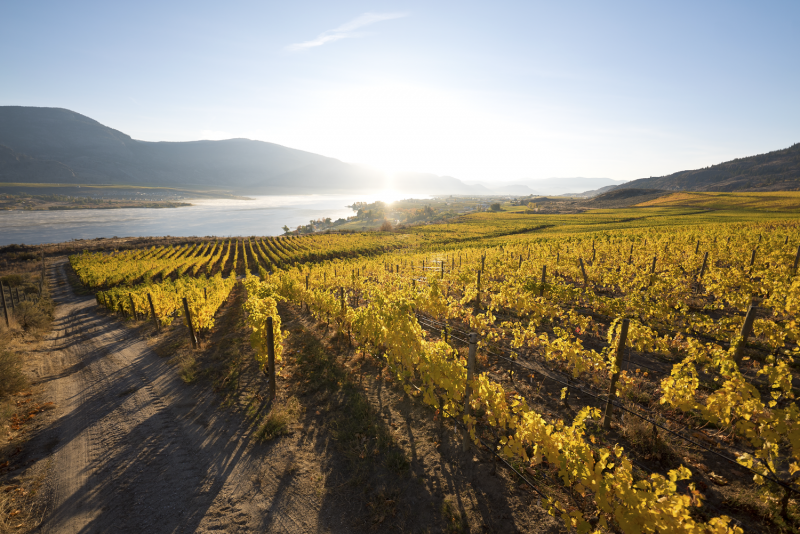A subtle hint of wild sage carries on the light, mid-morning breeze. The shrub blankets the hillsides here in British Columbia’s southern Okanagan Valley. Some 400 metres below, the cobalt surface of Osoyoos Lake ripples gently under the warming sun that reaches down from a near cloudless sky. Standing among the vineyards of the Osoyoos Larose winery, it’s hard to grasp that it’s actually nearing the end of November. But the region has been enjoying a prolonged mild streak, which is just what the Merlot, Cabernet Sauvignon, Cabernet Franc, Petit Verdot, and Malbec vines need to build extra strength to deal with the frigid weather ahead.
“The weather this fall has certainly been glorious,” confirms Michael Kullmann, the winery’s former viticulturist and vineyard manager who has recently taken over the duties of winemaker and chief operating officer. Having studied and worked in Bordeaux, the climactic realities of the south Okanagan – which is effectively a desert – still, at times, takes him a bit of getting used to.
“It’s an extreme environment for sure,” Kullmann replies when asked about some of the challenges he didn’t face in Bordeaux. “In the summer of 2021 we dealt with the heat dome, with temperatures reaching almost 50 degrees [Celsius] in the vineyard at one point. We had twelve days where the temperatures were over 40 degrees [C] for more than 12 hours. Then, in early January, the temperature dropped to minus 25 [C], so there are some massive challenges. But Kullmann deems these to be good challenges. “The dry heat we get is ultimately necessary for the wine’s structure,” he notes, while cold winters allow for a sufficient amount of dormancy prior to bud break in the spring. “The south Okanagan is an amazing place to grow wine,” he sums up.
The region’s almost non-existent humidity means that the chances of vines being hit with mould and dampness-related funguses is greatly reduced, which makes the adaptation of organic practices much easier.
“We are 90 per cent of the way to organic anyway,” Kullmann reveals, “so changing the other 10 per cent of them hasn’t been too difficult. 2022 will be our first certified organic vintage…if all goes to plan, “because you just never know!”
Conceived in 1998 as a joint venture between Bordeaux’s Groupe Taillan (owner of Chateau Gruaud-Larose in Saint-Julien, among others) and Canada’s (at the time) Vincor, Osoyoos Larose (now fully under single ownership) winery was designed to be a producer of premium wines based on the Bordeaux model. Meaning that the wines would incorporate a blend of Bordeaux varieties and, as with many Bordeaux properties, fashion but a single wine (or a flagship and a second label – in the case of Osoyoos Larose, Le Grand Vin and Pétales d’Osoyoos respectively).

The estate’s 31 hectares of vineyards were planted on a west-facing slope over the course of 1999, 2000, and 2001, with the first vintage being crafted in 2001. Since that time, Osoyoos Larose has quietly won over the hearts and palates of the wine media, connoisseurs, and other winemakers. I say “quietly” because, with the exception of the occasional media tasting event, the winery hasn’t really engaged in any splashy promotional or marketing initiatives, choosing instead to just let the wines speak for themselves. There’s no opulent chateau. No merchandise infested tasting room. In fact, until very recently there wasn’t even a production facility the winery could call its own.

“It’s been a long, arduous process,” Kullmann concedes. “We had quite a large warehousing facility that we’ve converted into a winery. It’s incredibly functional, if not particularly, well, visually appealing. But it will allow us to group everything under one roof – from the lab, to offices, to production, aging and warehousing operations. The biggest source of delays has been securing a clean water source, as well as dealing with the various provincial regulators and other local and regional concerns. It’s all taken a lot longer than we wanted or planned. Our hope is that the 2023 vintage will take place using the new facility.”
Having more or less “perfected” its red wines, the winery is preparing to complement them with a Bordeaux-style white counterpart. While the project is still a bit hush-hush, Kullmann confirmed that just over a hectare of white varieties has been planted so far, with another eight or so slated for next year. Though the actual final composition of the blend is yet to be determined, it’s probably safe to assume it will follow the traditional Bordeaux blanc blend – predominantly Sauvignon Blanc and Semillion, with some Muscadelle to round things out.
For now, we’ll have to content ourselves with the red wines of Osoyoos Larose. Which isn’t a bad thing as there is plenty to be contented with.

I had the pleasure of tasting through a range of Le Grand Vin – a decade’s worth to be exact – from 2009 through 2018. Over the course of previous years, the assemblage shifted from being predominantly Cabernet Sauvignon, to more recent vintages that have seen Merlot making up about 60 per cent of the blend. The proportion of Cabernet Franc has also increased. Still showing some youthful black fruit, the Osoyoos Larose Le Grand Vin VQA Okanagan Valley 2009 (which seems destined to outlast the “definitely ready now” 2010 incantation) sports a blend of 58 per cent Merlot and 26 percent Cabernet Sauvignon. In contrast, the ripe, opulent Osoyoos Larose Le Grand Vin VQA Okanagan Valley 2017 blends 61.4 per cent Merlot with 14 per cent Cabernet Franc and 12 per cent Cabernet Sauvignon (in every vintage, Petit Verdot and Malbec round out the blend. The Osoyoos Larose Le Grand Vin VQA Okanagan Valley 2015 had, at 71 per cent, probably the highest Merlot percentage of the lot.
All of the vintages tasted were of uniformly high quality, as was the overall aroma and taste profile, which in practically every instance revealed the cassis, granite/graphite, coffee and tobacco nuances familiar to lovers of top-flight red Bordeaux wines. Difficult as it is to pick favourites, my top three would be the aforementioned 2017 – ripe and powerful, with dense black cherry, lead pencil, dried herb aromas and flavours, and velvety tannins. Lots of aging potential here. The dead-ringer for Bordeaux rouge Osoyoos Larose Le Grand Vin VQA Okanagan Valley 2012, with its vanilla bean, bramble, garrigue and mild smoke notes, and, finally, the awesome Osoyoos Larose Le Grand Vin VQA Okanagan Valley 2014. Saturated opaque purple in colour, it again was, stylistically, classic high-level Bordeaux, with layers of cassis, wet slate, fresh herbs and cigar box on the nose that led to a mouth-filling, ultra-rich palate, packed with black fruit and a kiss of sweet oak. Incidentally, this was also Kullmann’s pick for number one in the lot.
While many of the back vintages are going to be a bit scarce, the recent 2017 and 2018 vintages are both worth seeking out (the 2017 might actually outlast the 2018). The really good news? According to Kullmann, the 2019 “…is a superstar. It’s a fantastic wine that’s got incredible potential.”
Tod Stewart has been a beverage alcohol industry professional for close to 40 years. He is an award-winning journalist and published author who has worked as a consultant, trainer, and educator to the hospitality industry, the Ontario wine industry, and the beverage alcohol trade. He has traveled and written extensively about international food, drink, culture, and history. His book, Where The Spirits Moved Me is currently available on Amazon and Apple. His cocktail of choice is a classic martini and the best concert he ever attended was Jethro Tull in 1978.
